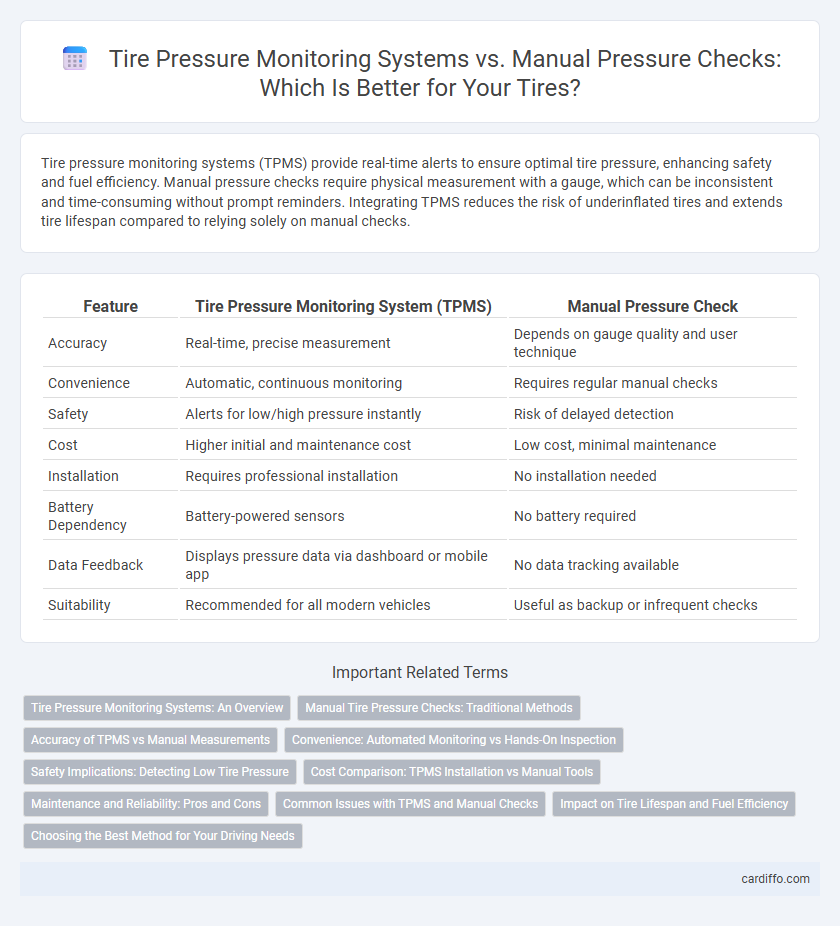Tire pressure monitoring systems (TPMS) provide real-time alerts to ensure optimal tire pressure, enhancing safety and fuel efficiency. Manual pressure checks require physical measurement with a gauge, which can be inconsistent and time-consuming without prompt reminders. Integrating TPMS reduces the risk of underinflated tires and extends tire lifespan compared to relying solely on manual checks.
Table of Comparison
| Feature | Tire Pressure Monitoring System (TPMS) | Manual Pressure Check |
|---|---|---|
| Accuracy | Real-time, precise measurement | Depends on gauge quality and user technique |
| Convenience | Automatic, continuous monitoring | Requires regular manual checks |
| Safety | Alerts for low/high pressure instantly | Risk of delayed detection |
| Cost | Higher initial and maintenance cost | Low cost, minimal maintenance |
| Installation | Requires professional installation | No installation needed |
| Battery Dependency | Battery-powered sensors | No battery required |
| Data Feedback | Displays pressure data via dashboard or mobile app | No data tracking available |
| Suitability | Recommended for all modern vehicles | Useful as backup or infrequent checks |
Tire Pressure Monitoring Systems: An Overview
Tire Pressure Monitoring Systems (TPMS) provide real-time data on tire pressure by using sensors mounted inside each tire, enhancing safety and fuel efficiency compared to manual pressure checks. TPMS can detect under-inflation promptly, reducing the risk of blowouts and improving tire lifespan, whereas manual checks require regular physical measurement with a gauge. Modern vehicles equipped with direct TPMS offer automated alerts to drivers, ensuring optimal tire performance without relying on manual interventions.
Manual Tire Pressure Checks: Traditional Methods
Manual tire pressure checks involve using a handheld gauge to measure air pressure, providing immediate and accurate readings specific to each tire. This traditional method requires regular attention, usually weekly, to ensure optimal tire inflation, which directly impacts fuel efficiency, tire wear, and vehicle safety. Unlike tire pressure monitoring systems (TPMS) that alert drivers electronically, manual checks demand routine physical inspection but allow for precise calibration based on the manufacturer's recommended psi levels.
Accuracy of TPMS vs Manual Measurements
Tire Pressure Monitoring Systems (TPMS) provide continuous real-time data with accuracy typically within +-1 psi, significantly reducing human error compared to manual pressure checks, which rely on sporadic, user-dependent measurements using analog or digital gauges. TPMS sensors maintain consistent monitoring even during vehicle operation, detecting subtle fluctuations that manual checks often miss due to infrequent inspections. The integration of TPMS enhances driving safety by ensuring optimal tire pressure, which improves fuel efficiency and tire longevity more precisely than traditional manual methods.
Convenience: Automated Monitoring vs Hands-On Inspection
Tire pressure monitoring systems (TPMS) provide continuous, real-time updates on tire pressure, eliminating the need for manual checks and enhancing driving safety through immediate alerts. Manual pressure checks require physical interaction with a gauge, which can be time-consuming and subject to human error, leading to inconsistent monitoring. Automated TPMS offers superior convenience by ensuring accurate tire pressure maintenance without the hassle of routine hands-on inspections.
Safety Implications: Detecting Low Tire Pressure
Tire pressure monitoring systems (TPMS) continuously detect and alert drivers to low tire pressure, enhancing safety by preventing tire blowouts and improving vehicle handling. Manual pressure checks, often infrequent and prone to human error, delay the identification of underinflated tires, increasing the risk of accidents. Accurate and timely pressure detection through TPMS significantly reduces the chances of tire failure and improves overall road safety.
Cost Comparison: TPMS Installation vs Manual Tools
Tire Pressure Monitoring Systems (TPMS) installation typically involves an upfront cost ranging from $50 to $200 per sensor, plus professional installation fees that can total $100 to $300, whereas manual pressure gauge tools cost between $5 and $40, requiring no professional service. While TPMS offers continuous real-time monitoring that can prevent tire damage and improve fuel efficiency, the initial investment and sensor replacements may outweigh the affordable, one-time purchase of manual tools for budget-conscious consumers. Long-term, TPMS can reduce maintenance costs by detecting underinflation early, potentially saving more money compared to the sporadic use of manual gauges.
Maintenance and Reliability: Pros and Cons
Tire pressure monitoring systems (TPMS) provide continuous, real-time pressure data, enhancing maintenance accuracy and vehicle safety by alerting drivers instantly to pressure drops. Manual pressure checks rely on periodic measurements with a gauge, requiring consistent effort and increasing the risk of overlooked underinflation that can compromise tire reliability and fuel efficiency. While TPMS reduces human error and promotes timely interventions, manual checks allow for visual inspection but depend heavily on driver diligence and frequency.
Common Issues with TPMS and Manual Checks
Tire Pressure Monitoring Systems (TPMS) can experience sensor malfunctions, signal interference, and battery failures, leading to inaccurate pressure readings that compromise safety. Manual tire pressure checks, though reliable, are often prone to human error, inconsistent measurement frequency, and reliance on properly calibrated gauges. Both methods require regular maintenance and verification to ensure optimal tire performance and prevent uneven wear or blowouts.
Impact on Tire Lifespan and Fuel Efficiency
Tire pressure monitoring systems (TPMS) ensure consistent optimal tire pressure by providing real-time alerts, reducing underinflation that accelerates tire wear and diminishes fuel efficiency. Manual pressure checks, often performed irregularly, risk prolonged periods of improper inflation, leading to uneven tread wear and increased rolling resistance which drains fuel economy. Maintaining correct tire pressure through TPMS extends tire lifespan by up to 25% and improves fuel efficiency by approximately 3-5%.
Choosing the Best Method for Your Driving Needs
Tire pressure monitoring systems (TPMS) provide real-time pressure data and alert drivers to under-inflation, enhancing safety and fuel efficiency. Manual pressure checks require a reliable gauge and regular attention but allow for precise inflation adjustments based on specific driving conditions. Selecting the best method depends on your driving habits, vehicle type, and preference for convenience versus hands-on maintenance.
Tire pressure monitoring vs manual pressure check Infographic

 cardiffo.com
cardiffo.com